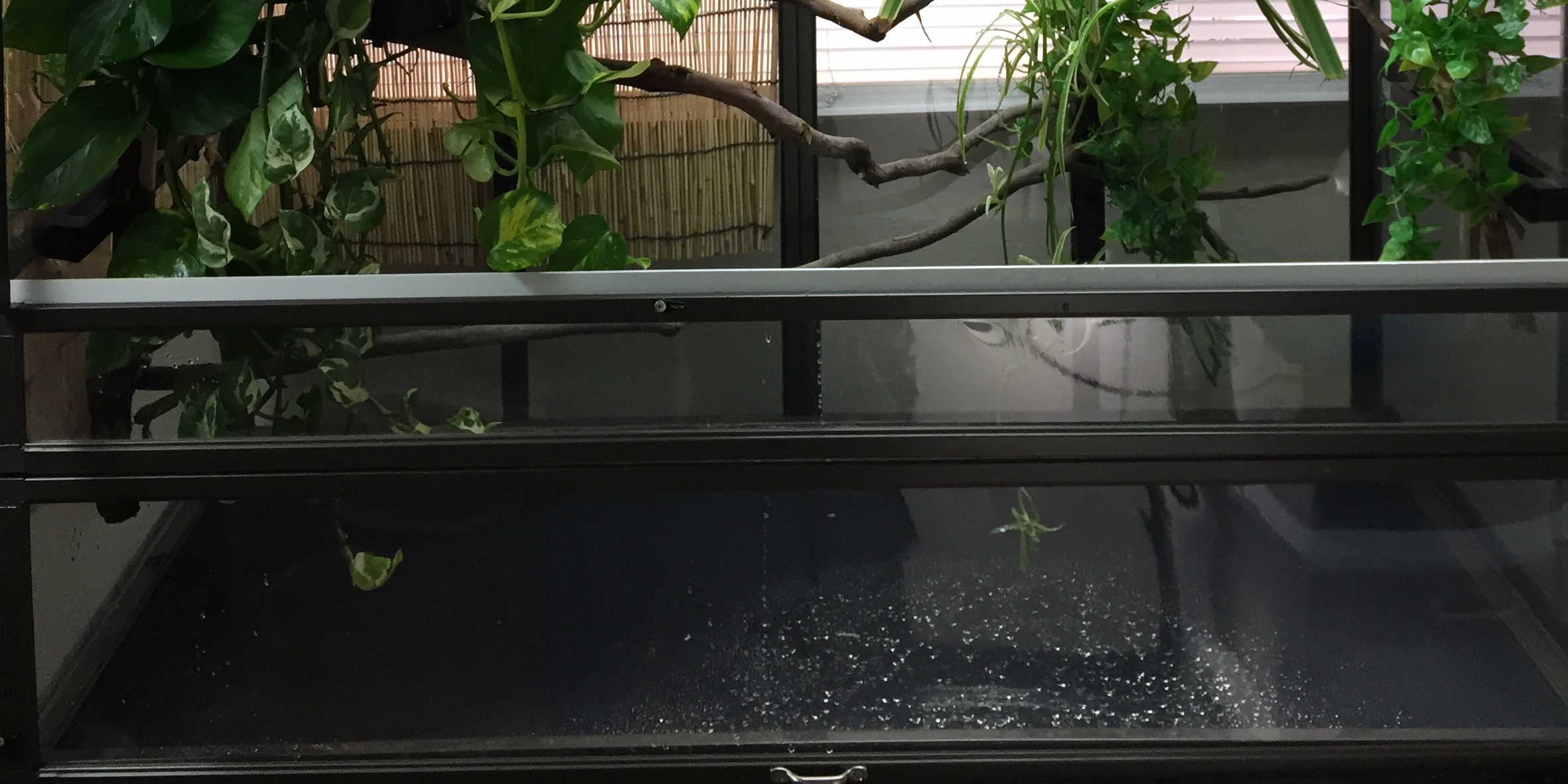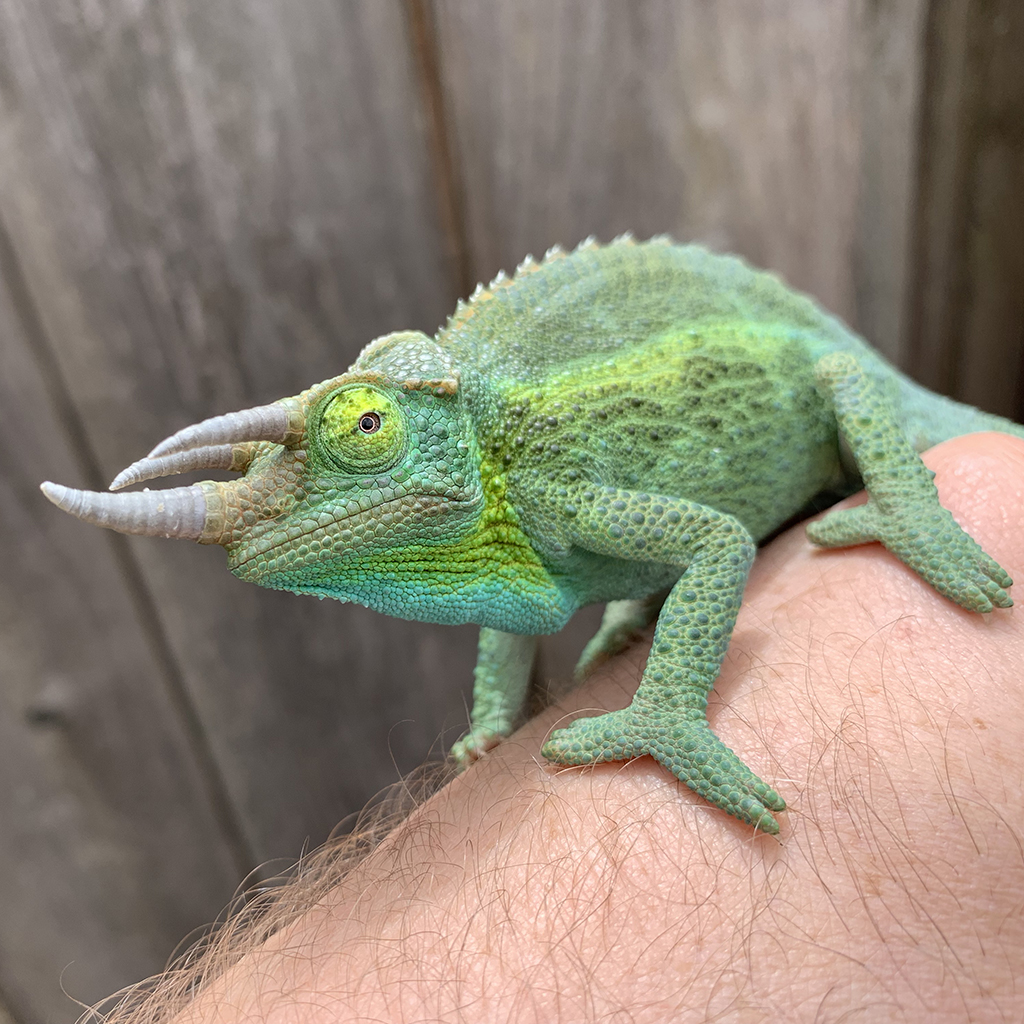Summary: How to set up your chameleon cage floor
- An effective drainage tray solution collects the waste water outside the cage
- Keep waste water away from chameleons, feeders, and poop
- A substrate tray inside the cage is not an effective drainage solution
- Substrate trays are for holding soil
- Keep soil floors and bio-active for later in your hobby growth
Introduction to your cage floor
The cage floor is not that important to your chameleon. They will usually spend much of their time in the upper half of the cage. So the cage floor is mostly a logistical concern for us with respect to how we handle waste water that has dribbled off the leaves, escaped feeder insects, and chameleon poop.
In the chameleon world there are three major options for the floor of your chameleon cage.
- Solid Plastic Floor Panel. .
- Screen Floor Panel. The “Drip Easy” system offers a screen panel in place of the standard plastic floor panel.
- Soil Substrate
Each of these have different uses and we will review each one.
This section is additionally important because most commercially made cages come with substrate trays as accessory options. As we will go over, substrate trays are inadequate to act as drainage trays. At the time of this writing, Dragon Strand is the only chameleon caging company that offers drainage trays. They do offer drainage trays in sizes that fit other manufacturers. Whether you purchase a drainage tray specifically made for a chameleon cage or find an alternative tray, you must have a drainage strategy in place.
Substrates are interesting – especially bio-active substrates – but they are a project that requires research and attention to maintain. My standard advise is to keep your floor clear until you feel you have chameleon husbandry under your belt and are ready to take on a subsequent challenge.
Things are slightly muddled due to the major cage suppliers offering only substrate trays as accessories for their cages instead of drainage trays. If you intend to collect waste water you do not get the tray that goes inside the cage!
Plastic panel for your chameleon cage floor

Most commercially made cages come standard with a PVC plastic floor panel which sits on top the bottom frame of the cage. These floors are not water tight. Water pools until it flows over the side of the floor panel.
These floor panels are simple and have wide application. They provide at least a minimum of support for potted plants placed on the floor.
The disadvantage to a solid floor is that water collects on top of the floor until the water tension breaks and it flows to the side of the floor panel and drips out of the cage. This is a disadvantage because this entire process allows the mixing of water, escaped feeder insects, and chameleon poop. This is a bacterial mess that is best to be avoided as that escaped feeder insect may get all bacteria laden and then get eaten. One way to increase drainage is to drill small drainage holes through out the floor panel and especially anywhere where potted plants have created an indention in the floor (which will encourage the water to pool under potted plants where the crickets love to hide…you can see where this is going).
Cages with plastic floors will need a drainage tray, or other drainage solution, to collect any waste water.
"Drip Easy" screen panel for your chameleon cage floor
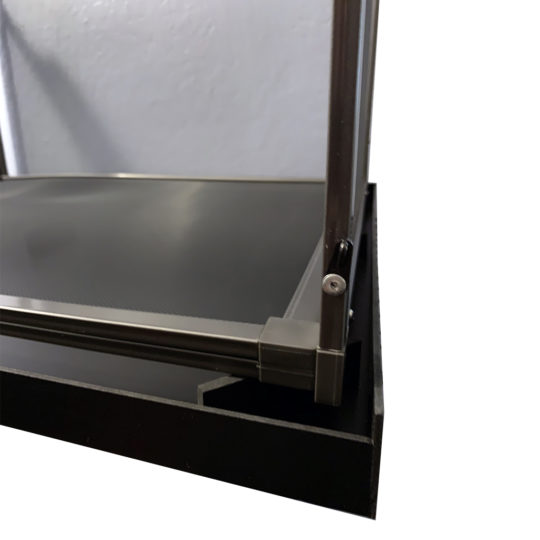
The “Drip Easy” drainage system is simply a screen panel which replaces the PVC plastic floor of the cage. The purpose of this is to increase drainage to as close to 100% as possible. With no retained water, there is no “poop soup” with poop, water, and feeders.
The Drip Easy system was introduced to the chameleon world by Ed Kammer of Kammerflage Kreations and is now offered on Dragon Strand cages with permission from him.
An unintended benefit of the Drip Easy system is that the screen panel makes the bottom of the cage visually disappear. For cage set ups that landscape up the side, this provides an aesthetic appeal.
The Drip Easy is not ideal for cage set ups where there are potted plants on the bottom of the cage. People do it and as long as there is support and no friction or falling, it will work. But the Drip Easy system is ideal if you have used Dragon Leges to mount potted plants to the side of the cage and the floor is clear.
Cages using the Drip Easy floors will need a drainage tray, or other drainage solution, to collect any waste water. This is usually not a problem because the Drip Easy is offered only by Dragon Strand and only as a bundle with an appropriately sized drainage tray.
Substrate Floor

While chameleons do not need a floor of any kind, a substrate floor can be beneficial is you are creating a holistic environment of which the chameleon is only one part of.
Bio-active substrates, where there are living invertebrates living in and cleaning the soil, are gaining in popularity. But be warned that every living thing needs to be maintained. A bio-active substrate is not difficult, but it is yet another thing to monitor and trouble shoot. We will review substrates and bio-active substrates extensively further in a future term. Although I am encouraging you to put aside a substrate at this point, our end goal or “senior project”, will be to create a completely living environment. But for now, let’s worry about simply establishing a proper drainage system. We can (and will) add complexity later!
What is a Drainage Tray?

There are a handful of plastic trays available for commercially made chameleon cages. The marketing is non-specific on these so it can be confusing. Bottom line: If it sits inside the cage it is a substrate tray. If it sits under the cage it is a drainage tray. Now, there are some substrate trays that are large enough that they sit under the cage, but these are homemade (see the section on substrate trays!).
The main identifying purpose for a drainage tray is that it collects any excess water and keeps it apart from the chameleon cage. It keeps the waste water, poop, escaped feeders, and the chameleon from coming in contact with each other.
What is a substrate tray?

A Substrate Tray goes inside the cage and is meant to provide a planting area (not for drainage). The proper use for a Substrate Tray is to create a living floor or even just a heat sink in outdoor scenarios.
Substrate trays should not be used for a drainage solution as they keep the chameleon in contact with the bacterial nightmare of mixing poop, water, and feeder insects (living and dead/decaying). This is worth repeating as most of the trays available at the reptile stores or websites are substrate trays. Substrate trays are much easier and cheaper to make so that is the direction mass manufacturer companies go towards. Their target customer is the very new beginner that will not know the difference in trays.
Puppy pads and paper towels
Since most of the major caging companies offer only substrate trays for their cages, a common approach has been to line the bottom of the cage with puppy pads or paper towels. The pads soak up the excess water and then are thrown away or dried for use again.
While this works to soak up water, this approach keeps the waste water in the cage with the chameleon and does nothing to keep moisture from the poop and roaming feeder insects. Thus, lining the bottom of a substrate tray with water absorbent pads is not a satisfactory solution for the problem.
How to find a drainage tray
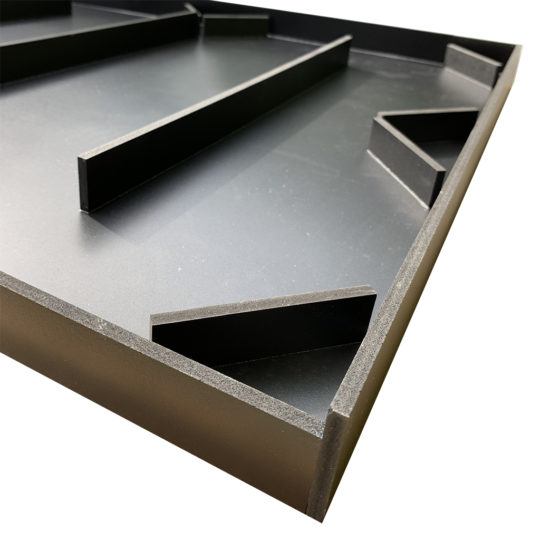
At this time (and for the last many years), the Dragon Strand Chameleon Caging company the only US based chameleon caging company that makes true drainage trays for their cages. In Europe, a company called Muji offers fitted drainage trays for standard cage sizes. All others either offer nothing or offer substrate trays. This is because true drainage trays are hard to make. Either they are molded or hand built. Molded options are very expensive to create and any further steps, such as adding a drain, are costly. Making the trays manually is time intensive and the construction process requires skilled labor to get it looking professionally made. Through the Dragon Strand chameleon cage company I explored reducing costs by sending the pieces and having the customer glue them together. The process was not clean and I had to shelve the idea. Drainage trays may look simple, but they are no where near simple to make!
Dragon Strand does have a few options which are compatible with other manufacturers. These are the cleanest solutions as they are specifically designed for chameleon cages.
If you prefer to put one together yourself, find a water tight tray in the garden center of your home improvement store, pick up a washing machine drip tray, or look for dog crate replacement trays. Anything that can hold water and is big enough for the cage to sit in will suffice. Though you will need to find a way to support the cage so it is about 1″ above the bottom of the drainage tray. This is so the cage does not sit in the waste water. Any kind of spacer can be used from a frame made from PVC pipe to any sort of small make-up jars. It can be anything that can sit in water and support the weight of the cage and any plants resting on the cage floor.
Emptying the Drainage Tray
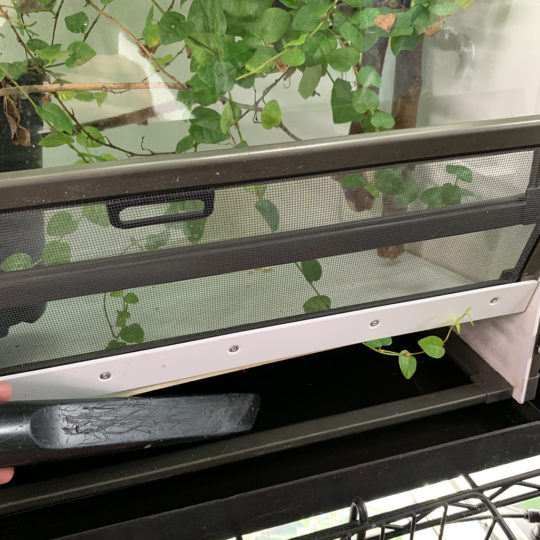
Depending on how much water is put through the system, the drainage tray may be sufficiently emptied via evaporation. If not then the try may be emptied using items ranging from a simple turkey baster to a wet/dry vac. There is no need to lift the cage off the tray. Get a crevice tool for your wet/dry vacuum and suck the water from around the cage edges, or else lift up the cage service door and stick the nozzle under the floor into the drainage tray. Note, you do not want to lift up the cage and you definitely do not want to slide or move the drainage tray that is full of water. You do that once and with the water sloshing around you quickly learn why it is not a good idea.
Substrates
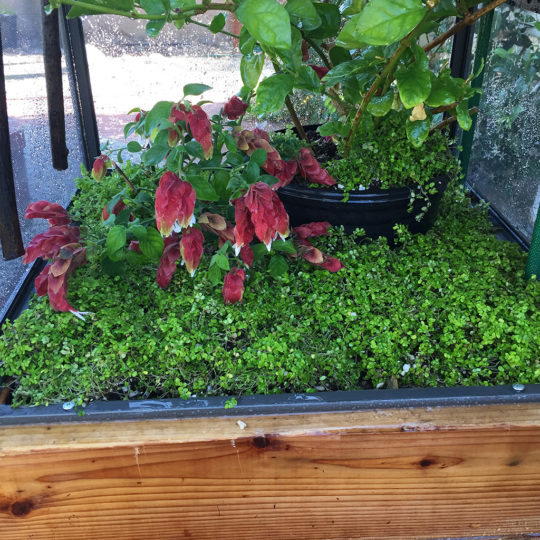
Including a substrate for a chameleon cage is not necessary for the chameleon and, for the standard chameleons, offers little direct benefit. But, at the same time, it can be incredibly rewarding for you to grow live pants or even explore a bioactive substrate. As a beginner it is best to keep a plain floor. Substrates are a complication that you should not take on. But as a chameleon keeper grows in their skill they will more and more embrace the naturalistic approach and a soil substrate will be just one component in the keeping of an environment rather than just the keeping of a chameleon.
Outdoor caging is the exact opposite, though. A substantial substrate helps the entire cage be balanced. Without a substrate, the sun reflects off the floor and cooks the chameleon from both sides. A substrate allows a natural temperature and humidity gradient.
Conclusion
The floor of the cage is often over looked. But it is an important part of the entire picture. When you are starting out, the ideal floor would be the Drip Easy set up with your plants up along the sides of the cage. This gives you the maximum drainage with no hiding spots for crickets. The next best floor in line would be a bare plastic floor with drainage holes drilled in. If there are potted plants making indentations in the floor then drill your drainage holes around and under your pot. This encourages drainage in the places where water and escaped feeder insects are likely to congregate.
Implementing a substrate is a project on its own and, unless that becomes a passion for you (for many people, bio-active substrates are an interest in itself!), leaving the floor clear is the best.
Regardless of whether you implement a substrate or not, have a plan for your drainage strategy!
Navigation
This seminar is part of the introductory course Chameleon Basics which, in turn, is a module within the even larger Term 1: Getting Started With Chameleons.

